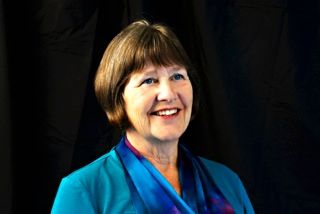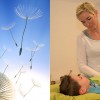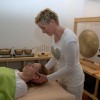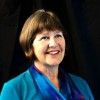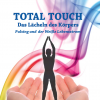Peta Joyce
An integrative approach to health seeks to respond to humans as whole beings. This is predicated on a unitary worldview where “the person is seen as a unitary whole without seeing any aspect as primary or secondary” (Broom, 1997, p. 24). Through this unitary approach “we are led to radical new understandings of disease, the simultaneity of mind and body, and the nature of reality” (Broom, 2002, p. 18). We are multidimensional, interconnected beings, living and interacting within a subjective as well as objective personal, social, cultural, natural and spiritual universe. According to Wilber (2005, p. xxxi.) “Body and mind and spirit are operating in self and culture and nature, and thus health and healing, sickness and wholeness, are all bound up in a multidimensional tapestry that cannot be cut without loss”.
In contrast to the unitary approach, the dualistic approach sees humans as being discrete and separate ‘parts’ or ‘aspects’, which make up the whole, and is a legacy of the Newtonian-Cartesian or body-as-machine world view. This biomedical model still underpins many approaches to health, including some fields of complementary or alternative medicine.
This paper focuses on the use of touch to facilitate body-mind awareness and integration with a particular pulsee or client. Holistic Pulsing asks how the person is in relation to themselves as a whole, using the ‘window’ of body awareness (via the ‘hands on’ imparting of gentle rocking and stretching movement to the physical body of the clothed client accompanied by dialogue) as a tool for accessing this awareness.
Kathy was a pulsee (client) in her middle years who was on a sickness benefit for chronic fatigue and incapacitating lower back pain. She had “tried many things” from conventional to complementary therapies, but felt that none of them was helping. When I first met Kathy she lacked hope that she would ever get better and had lost any sense of meaning, purpose or direction in her life. She felt negative about her body size and shape and felt ‘out of control’ of her eating. Kathy talked about her condition from many perspectives, outlining her physical symptoms, her emotional responses, her own self-analysis and her spiritual beliefs. She believed she had inherited her ‘life paradigm’ from her birth experience where she had an induced early birth and no bonding with her mother. She suspected that her lower back pain was “stuff I don’t want to see”. She had lost her capacity to earn income, and all her assets were gone since becoming ill. Kathy was sophisticated and knowledgeable about integrative approaches to healing, and sought out Holistic Pulsing specifically to explore how this approach could help her.
What is the role of touch in integrative medicine? Nathan argues that physiology and psychology are inextricably linked, and denying the psychological component of manual therapies (or conversely the importance of the body in psychotherapy) is a disservice to the notion of the whole person. He argues that the Cartesian heritage still underpins much of manual therapy and “…the use of manual touch as a healing mode should be explored for its psychotherapeutic, in addition to its mechanistic significance.” (Nathan, 1999, p. 4).
Aposhayan (2004, p. x) argues that “the body and mind are fundamentally connected in psychological development and growth.” Dreher points out that even the word ‘connection’ does not adequately describe the synergistic interplay of mind-body relationships. He says “Mind and body are not connected; they are unified” and “The basic science of mind-body unity suggests that every shade of emotion and every facet of selfhood is curled together with bodily states relevant to health.” (Dreher, 2003, p. xv).
Nathan makes a distinction between procedural touch (physical intervention of a medical nature) and expressive touch (conveying feelings, attitudes and sentiments). He says “The manual therapy disciplines, having arisen in the shadow of Western scientific thought, have attempted to place touch forms in a procedural or technical framework. Holding, rocking, rubbing and stroking touches, which all these therapies embrace, are procedurised versions of expressive touch forms. It is natural, therefore, that members of these professions are fighting hard to ascribe physiological rationales to their techniques in an attempt to become or remain scientifically acceptable.” (Nathan, 1999, pp. 94-95). He points out that expressive touch, rooted as it is in original forms of healing (such as holding and rocking a distressed child), cannot be ignored as a means of healing in manual therapies. Totton (2003, p. 131) sees the use of the medical model (in bodywork) as a possible defence against ‘frightening’ feelings in the therapist or their clients and a way “…to evade the rigours of transference and counter-transference interpretation.”
Totton (2003) outlines five levels of touch used in body psychotherapy; touch as comfort, touch to explore contact, touch as amplification, touch as provocation, and touch as skilled intervention. He notes that some theorists see comforting touch as a way to suppress a client’s process, to prematurely gratify the client’s needs, or to be seductive. Other theorists see it as facilitating regression or as simple human support. According to Totton, what is vital in the use of any kind of touch is scrupulous attention by the practitioner to the intention of the touch, possible transference issues, and most importantly, how touch is perceived by the client.
In Holistic Pulsing, touch is used to explore and amplify a client’s inner awareness, to facilitate expressive discharge where appropriate, and to elicit information about patterns of holding, tension and freedom of movement in the client’s body-mind. Kathy found gentle touch and rocking work around her hips and lower back especially beneficial and was able to connect deeply with her hip and pelvic bones. She expressed this as an awareness that her bones “didn’t get enough of something in my childhood to enable them to grow”. As her hips were the expected size and physiology of an adult, I assumed that this was a symbolic statement about what she had lacked in order to ‘grow’ or develop fully through her childhood. Broom (2006) and others point out the importance of the symbolic nature of illness.
As the work progressed on Kathy’s hips, she felt we were ‘feeding’ her bones, and ‘forming’ her sense of self. It seemed her bones were a key to her inner knowledge and development of self. Chiozza (1998) uses psychoanalytic theory to link affect with physical disorders, and relates bones to feelings of security, support and protection. He outlines three key phases of the physiological development of bones, which coincide with three important phases of libidinal development. Hartley advocates focusing awareness on body systems through mindful touch in order to restore a healthy sense of body boundaries and containment in clients with an undeveloped or wounded sense of core self. She says, “For many the bones, embedded with mineral deposits of the earth, offer support and security” (Hartley, 2005, p. 138).
Kathy often reported pleasurable sensations of increasing warmth in her bones and kidneys, expressing sounds of pleasure and satisfaction as we worked. Nathan (1999) calls attention to the usually unacknowledged role of pleasure in healing, pointing out that the client’s sensory-psychological experience is just as important a factor in healing as the practitioner’s technique, and that the two are deeply interconnected.
The sense of being ‘held’ was particularly important to Kathy; she associated not being held as a baby with the hunger her body felt for firm, sensitive touch. We gradually expanded the touch and rocking outward from the hips to her whole body, which gave her a sense of being ‘connected’ as a whole person for the first time in her life. For example, when I moved my hands from her hips to her lower body, she became aware for the first time that her hips and legs were physically connected to each other, and reported an awareness of “being connected with the earth”. This sense of herself as connected (both within herself and with the earth) was a revelation to her.
Here we have echoes of the ‘lived body’ of the phenomenologists like Merleau-Ponty who saw no separation between our “sentient body” and the “body of the land”. (Merleau-Ponty, 1968, as cited by Abram, 1997, chapter 2). Nathan uses a phenomenological approach to explaining the psychological impact of being held and touched. At some level, most clients feel loved and valued when physically treated because, as babies, being held and touched “is how valuing or loving is enacted in the world.” (Nathan, 1999, p. 20) He says, “Movement expresses life. The muscular tissues are the moving tissues. They move according to how our lives are lived and deserve special attention as agents of our essence.” (Nathan, 1999, p. 61).
Tune outlines historical and current controversies around the use of touch in psychotherapy, concluding that the ethical use of touch has its place as a meaningful form of human expression. Positive touch, he says, can be “evocative, stabilizing, nurturing and relational.” (Tune, 2005, p. 77). Heuer (2005) believes that prohibitions around touch and the body in psychotherapy may be an expression of the body/mind split still evident in Western culture.
Some psychotherapists avoid touch altogether because of its association with sexuality and power, and for fear of litigation. Totton (2003, p. 124) concludes that touch can be “both erotic and regressive” and that precisely because touch facilitates infant experience “is in fact a large part of the reason for using it therapeutically.” However, he believes regression is not always useful, for example where attempting to meet the client’s regressive needs for comforting touch may be insatiable, or where re-traumatisation occurs. Nathan (1999) argues that working purely from a mechanical or physiological basis in manual therapy increases the body/mind split and lack of awareness or even denial of the psychological issues of touch and the therapeutic relationship. On the other hand, including the psychological dimension raises professional boundary issues for manual therapists.
Touch brings up issues of transference and counter-transference because “…relationship and embodiment are wholly entwined with each other; and damage to relationship is functionally identical with damage to embodiment” (Totton, 2003, p. 128). Rothschild (2000) eschews touch in psychotherapy specifically because of the dangers of transference and counter-transference, particularly in relation to certain types of trauma clients. She also points out the need to respect client boundaries, particularly where there is a history of sexual or physical abuse. Tune (2005) argues that simply avoiding touch in psychotherapy does not avoid the issue; his research cites numerous examples where touch did not occur but was still seen as an issue for either clients or therapists. Orbach argues the importance of bringing the body into the therapeutic relationship and questions the wisdom of not using touch in psychotherapy because “Touch is a fundamental way in which we come into our subjective sense of our body.” (Orbach, 2003, p. 20). Underlying the concept of transference is a belief that we are separate beings, whereas from a phenomenological perspective, what exists in the therapeutic encounter is mutually shared (Orange, 2002).
Sensory stimulation has long been seen as pivotal in early development (Goldberg, 2000) and neuroscience is showing us the intimate bio-psychological process involved (Schore, 2001; Carroll, 2005). Tune points out the centrality of the body and the importance of touch when working with early attachment disorders and trauma. He quotes Reuven Bar-Levav who argues that touch can be a “developmentally reparitive experience” (Tune, 2005, p. 71) and denying touch on the basis of erotic transference is based on the therapist’s fears rather than on any theory. Carroll (2005, p. 28) believes that “Bodywork can be a bridge to self-regulation, including more awareness of the self-in-relationship. It can also become a vehicle for collusion and re-enactment…inadvertently recapitulating the early attachment trauma.”
Totton (2003) identifies some aspects of transference particularly relevant in bodywork: the identification by the client of the practitioner with any adults involved in early trauma (either social or physical), fantasies by the client (and sometimes the practitioner) of enacting a ‘cure’ (literally through ‘the laying on of hands’) and sexual fantasies.
The transference issues that I was aware of in relation to the pulsee (client) involved the potential for abandonment and for re- traumatisation. When Kathy first came to me, I was clear with her that I would be going overseas in five months. She happily accepted that, but as the sessions deepened I was concerned not to replicate a possible experience of abandonment by her mother. I was assisted by supervision from a psychotherapist, who coached me through making the transition as carefully as possible. The need for this was verified when Kathy said in her second-to-last session that she was more upset than she realized by my going, and she felt “as though I were her mother”. We talked through the possibility that she had transferred her feelings to me as a kind of ‘surrogate’ mother, and how to care-take that process. Kathy decided she would see another therapist (who worked in a similar way to me) for continued support, and had her first session with the other therapist before we completed. Soth sees re-enactment (of the original wound between child and other being played out between client and practitioner) as “…one of the essential features of a participative universe.” (Soth, 2005, p. 50) and argues for a surrender to the inevitability of re-enactment as an aspect of the “multiple parallel processes resonating throughout the therapeutic relationship and the body/mind of both people involved.” (Soth, 2005, p. 55).
Kathy often queried whether or not she had been ‘abused’ and sometimes had a somatic memory of being hit, although she had no conscious memory of being hit as a child. Staunton (2002) outlines two types of memory: explicit and implicit. She argues that ‘body’ and ‘somatic’ memory are the unconscious, implicit memory, which is why body awareness can be a way to integrate traumatic experience.
According to Kalsched (1996), trauma can come from either the acute experiences of child abuse, or from cumulative unmet dependency-needs. Kathy’s history indicated the possibility of early trauma from either source. I needed to be particularly alert to the potential for re-traumatisation through ‘triggering’ traumatic memories (especially through the use of touch) or even ‘re-constructing’ explicit memories of abuse from somatic memory (Rothschild, 2000).
Kathy was also seeing an osteopath for her back pain. She gained reassurance about the structure of her body, but only short-term relief from pain after ‘corrective’ sessions. She also experienced psychological trauma after deep work in her gluteal muscles during a massage. I believe that treating Kathy from a dualistic perspective as a passive ‘object’ (a mechanical body, or set of muscles) rather than as a ‘whole’ person was unhelpful, possibly re-activating the lack of caring and power imbalance she experienced in her childhood.
What value, if any, does touch have in working with trauma? Juhan talks about ‘engrams’ as the “the cortex’s means of learning new skills and behavioural patterns” and the importance of sensory information in this process (Juhan, 1998, p. 275). He details the positive effect of bodywork on traumatic engrams, a kind of re-patterning of the person’s responses through the sensory evocation of, for example, the feeling states of pleasure, softness, lengthening and relaxation through subjective and intuitive touch. Because body and mind are a coordinated whole, not only does this bring relief to the physical body, but a “…conscious reaffirmation of the kinds of thought forms and feeling states that are themselves the effective mechanisms of relaxation, the reassertion in the conscious awareness of the client of his tactile sources of information, body image, and self control.” (Juhan, 1998, p. 276).
As the sessions progressed, Kathy became more trusting and relaxed, felt more in control of her eating, and insightful about the role of food in her life. She moved from talking about her painful childhood situation and wondering about ‘abuse’ to talking about her present direction and purpose in life. She often reflected on a feeling (both within and outside sessions) of being in conflict between different paradigms. Sometimes this expressed itself in her painful back as “how can I support myself if I let go (of control) and surrender (to what life brings)?” Her lower back pain gradually subsided from ‘unbearable’ to ‘manageable’ without painkillers, and I noticed an increase in her mobility and physical flexibility during the rocking movement and after the table work. Towards the end of our sessions her physical energy had improved, and she was able to contemplate returning to work.
In bodywork, the explicit contract between client and practitioner is one of physical contact. Many of the cautions or prohibitions around the use of touch come from the field of psychotherapy. However, in an integrative context, sticking rigidly to the use of manual therapy only, or talking therapy only, exemplifies the body-mind split. Totton (2003, p. 133) argues that “thought and language are qualities of the body itself” and therefore cannot be separated. Similarly, Nathan (1999) argues that physical and psychotherapeutic intervention cannot be separated. Although methods other than touch (such as Focussing (Gendlin, 1981) or Hakomi (Kurtz, 1990)) can be used to access somatic awareness, practitioners like Juhan and Nathan would argue that an embodied relationship with oneself, as expressed through appropriate physical contact, is a powerful factor in integrative healing. However, it is not touch per se that facilitates healing, but the way in which touch is given and received within the complex tapestry of the therapeutic relationship.
Kathy was seeking “an experience of positive touch” through massage. This subsequently brought her to Holistic Pulsing where the use of touch with dialogue helped her to access an awareness of herself not available through other methods of healing. As Nathan (1999, p. 139) says, “Holding and rocking allows unconscious, preverbal healing events to occur. Bodily feelings arising during the touching can be profoundly self-communicative, self-informing. They bridge pre-verbal gulfs, integrating and resolving old emotio-bodily confusions and conflicts. It is as if, in the containing hands of the manual practitioner, the body-self understands itself a little more and can relax and grow in such understanding.”
I believe that, by engaging with her body through touch, movement and dialogue, Kathy began living her experience of herself as a human being in a new way. Nathan (1999, p. 77) concludes that, if manual therapy is to truly be a whole-person therapy, it “needs to show how people’s physical, tactile lives form the ground of their experience as human beings.” Hartley (2005, p. 137) believes that “…bodywork and movement can help the adult client integrate a more fully embodied sense of core self”.
How therapeutic touch is used (or not) may have as much to do with therapists’ ideas about the nature of body-mind as with any perceived advantages or disadvantages. In Kathy’s case, touch was a positive, reparative (in relation to her sense of touch deprivation), embodying, and stabilizing process. I believe using touch in the context of a body-mind practice facilitated an integrative approach, enabling her to engage more fully with her healing journey.
In the wider context of integral medicine (Benda, 2005) we could see Kathy as creatively using her capacity for self-reorganization (Antonovsky, as cited in Dreher, 2003) to obtain the wider environment of support she needed (physical, financial and therapeutic) to become more “whole”.
REFERENCES
Abram, D. (1997). The spell of the sensuous: Perception and language in a more-than-human world. New York: Vintage.
Aposhayan, S. (2004). Body-mind psychotherapy: principles, techniques, and practical applications. New York, London: W.W. Norton.
Benda, W. (2005) in Schlitz, M, Amorok, T and Micozzi, M. Consciousness and healing: Integral approaches to mind-body medicine. Missouri: Elsevier Churchill Livingstone.
Broom, B. (1997). Somatic illness and the patient’s other story. A practical integrative mind/body approach to disease for doctors and psychotherapists. London: Free Association Books.
Broom, B. (2002). Somatic metaphor: A clinical phenomenon pointing to a new model of disease, personhood, and physical reality. Advances in Mind-Body Medicine, 18 (1), 16-29
Broom, B. (2006). Meaning-full disease. How personal experience and meanings initiate and maintain disease. Unpublished manuscript.
Carroll, R. (2005). Neuroscience and the ‘law of self’, in N. Totton (Ed.) New dimensions in body psychotherapy. Maidenhead: OUP.
Chiozza, L. (1998). Hidden affects in somatic disorders. Connecticut: Psychosocial Press Madison.
Dreher, H. (2003). Mind-body unity: a new vision for mind-body science and medicine. Baltimore & London: The John Hopkins University Press.
Gendlin, E. (1981). Focusing. New York: Bantam.
Goldberg, S. (2000). Attachment and development. London: Arnold.
Hartley, L. (2005). Embodying the sense of self, in N. Totton (Ed.) New dimensions in body psychotherapy. Maidenhead: OUP.
Heuer, G. (2005). ‘In my flesh I shall see god’, in N. Totton (Ed.) New dimensions in body psychotherapy. Maidenhead: OUP.
Joyce, P. (2006). Analyse and critique Holistic Pulsing
from a unitary perspective. MindBody Paradigms (course 588830) assignment 1, AUT.
Juhan, D. (1998). Job’s body: A handbook for bodywork. New York: Barrytown.
Kalsched, D. (1996). The inner world of trauma. Hove & New York: Brunner-Routledge.
Kurtz, R. (1990). Body-centred psychotherapy: The Hakomi method. California: LifeRhythm.
Nathan, B. (1999). Touch and emotion in manual therapy. London: Churchill Livingstone.
Orbach, S. (2003). There is no such thing as a body. British Journal of Psychotherapy, 20(1).
Orange, D. M. (2002). There is no outside: Empathy and authenticity in
psychoanalytic process. Psychoanalytic Psychology, 19(4).
Rothschild, B. (2000). The body remembers. The psychophysiology of trauma and trauma treatment. New York: W.W. Norton.
Schlitz, M, Amorok, T and Micozzi, M. (2005) Consciousness and healing: integral approaches to mind-body medicine. Missouri: Elsevier Churchill Livingstone.
Schore, A. (2001). Minds in the making: attachment, the self-organizing brain, and developmentally-oriented psychoanalytic psychotherapy. British Journal of Psychotherapy, 17 (3).
Soth, M. (2005). Embodied countertransference, in N. Totton, (Ed.) New dimensions in body psychotherapy. Maidenhead: OUP.
Staunton, T. (2002). Body psychotherapy without touch: applications for trauma therapy. Body psychotherapy. New York: Brunner-Routledge.
Tune, D. (2005). Dilemmas concerning the ethical use of touch in psychotherapy, in N. Totton, (Ed.) New dimensions in body psychotherapy. Maidenhead: OUP.
Totton, N. (2003). Body psychotherapy. An introduction. Maidenhead: OUP.
Wilbur, K. (2005) in Schlitz, M, Amorok, T and Micozzi, M. Consciousness and healing: Integral approaches to mind-body medicine. Missouri: Elsevier Churchill Livingstone.
About the author:
Peta is a Certificated Practitioner and an *Experienced Teacher of HP. She is also a Mentor with the NZ HP Guild.
“I have a background in social science and integrative therapy, and have been involved with Holistic Pulsing since its first development in New Zealand. I am an Accredited Holistic Pulsing Practitioner, have a postgraduate qualification in MindBody Healthcare and teach Holistic Pulsing at Wellpark College of Natural Therapies.
I am practiced at working with many dimensions of the body-mind experience, from deep relaxation and self-awareness to releasing old patterns and trauma. I sometimes work in tandem with a psychotherapist for long-term issues.
My practice is in Montel House, a therapy clinic in West Auckland. I also work as a group facilitator, supervisor and mentor in the not-for-profit and complementary health sectors. Over the years I have developed methods for peer group and one-on-one mentoring or supervision and train groups to use these methods as an effective and practical professional development and support tool.”

